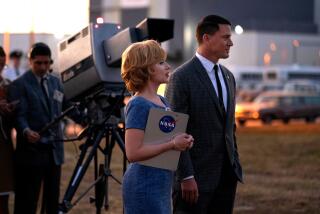Astronaut Encouraged Others to Reach for the Stars
- Share via
KARNAL, India — Like most daughters of India’s middle class, Neetika Gogia was raised to live within respectable limits and to accept that no dream is more important than marriage.
Columbia shuttle astronaut Kalpana Chawla taught her that even for a girl growing up amid the muddy streets and conservative ways of rural India, life’s possibilities are as boundless as the universe.
After Chawla flew her first mission on Columbia in 1997, she set up a program to bring two students each year from her old high school here to NASA’s International Space School in Houston. Gogia was one of them.
In 1999, at age 15, Gogia made her first trip outside India and flew to Texas, where she joined 41 other students from 16 countries learning about space exploration and science from the mouths of their living idols, NASA astronauts.
She also got to live with Chawla at her Houston home. They had a lot of time to talk -- about life back in India, about science and the challenges of outer space, and about what it took to make the long journey up from this world to the heavens.
As Chawla answered Gogia’s questions, and posed some of her own, the adventurous astronaut threw open the doors of a timid schoolgirl’s mind.
Now that Chawla is gone, Gogia feels as if she lost a friend, even a member of the family, in the fireball that streaked across the Texas sky.
“I’m still not able to understand what happened. It was really tragic, and I can’t put the feeling into words,” Gogia said Sunday. “She was always like my eldest sister.”
Chawla’s greatest strength was her determination, Gogia said.
Gogia is in her first semester of college at the Doon Valley Institute of Engineering and Technology in Karnal, about 70 miles north of New Delhi. She is focusing on electronics and one day wants to work at NASA, whether building the next generation of spacecraft or flying them.
It’s a dream that took shape in Texas, said Gogia’s father, Pushpinder Mohan Gogia, 51, a senior manager at India’s Bank of Baroda.
“We found that she’s totally changed after coming back from NASA,” he said. “She was just a girl when she went there. When she got back, she insisted that she also wants be an astronaut. I think she’s on the right path. She’s determined that one day she will go to live in America.”
At Chawla’s high school in Karnal, the Tagore Baal Niketan Senior Secondary School, about 300 students were setting off firecrackers and praying for her safe return to Earth when they heard the first TV reports that Columbia had disintegrated on reentry and all aboard had been lost.
Gogia and her father rushed to the school in disbelief and stayed until 2 a.m. Sunday, paying their respects and honoring a fallen heroine at a small shrine in the foyer, where incense burned next to a garland of marigolds draped over Chawla’s picture.
The private school prides itself on teaching students to chase their dreams with as much determination as Chawla did, and the astronauts’ deaths won’t deter them, said Deputy Director Daljit K. Madan.
Chawla “had gone to space with the philosophy ‘Do or die,’ ” Madan said. “That’s what we should teach our children. Our country needs people like that.”
Madan taught English and history to Chawla at Tagore and remembers her as a girl who knew where she was going and would let nothing get in the way.
At first, her parents didn’t want her to attend university in the U.S. They wanted her to settle down and get married before she was too old, or had too many college degrees.
In the end, it was Chawla’s mother who supported her, Gogia said.
Although Chawla became a U.S. citizen in 1990, she never forgot where she came from and was planning to return to Karnal in April to visit about 1,600 students at the school that had taught her to reach for the stars.
Each year since 1997, Tagore’s older students have competed in a science and poetry contest for the two seats at the NASA space school. Gogia won in 1999 with a recipe for freeze-dried beef and broccoli -- for dinner in orbit -- and a poem about Chawla called “The Universe.”
One day in Texas, when Gogia wasn’t in class, Chawla took her flying in a two-seater plane. In a 45-minute tour over Houston, the astronaut gave Gogia a sense of her wings by making the girl from Karnal her co-pilot.
“She told me to give directions,” Gogia said.
After just over two weeks at space school, it was time for Gogia to go back to Karnal. As a souvenir, Chawla gave her a zip-lock plastic bag containing a NASA decal and the crest of Columbia mission STS-107, with a shooting star encircled by the names of the seven crew members who would die together.
Gogia also has a note sent later by Chawla, who wrote it on the back of a space shuttle postcard dated Aug. 12, 2001. Gogia keeps it sealed in the plastic bag along with a few photos of her, Chawla and Chawla’s husband.
She wants those memories to last forever.
“You sure are one determined girl, and more than anything, that is very impressive,” Chawla told Gogia in the postcard. “We miss you, your charming, inquisitive manners, and your smile.”
Two days before Saturday’s return flight to Earth, Chawla sent an e-mail from orbit to students at India’s Punjab Engineering College, where she had enrolled at age 17 as one of only seven girls studying in a college full of men. She was the only woman to graduate in her aeronautical engineering class.
“The path from dreams to success does exist,” Chawla said in her e-mail from Columbia. “May you have the vision to find it, the courage to get on to it, and the perseverance to follow it. Wishing you a great journey.”
More to Read
Sign up for Essential California
The most important California stories and recommendations in your inbox every morning.
You may occasionally receive promotional content from the Los Angeles Times.













